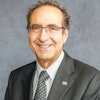
Radiology is experiencing a backlash among policymakers and other physicians that could threaten its future -- a backlash that's based in large part on its own success, said Dr. Bruce Hillman in a September 20 presentation at RADExpo 2012: The Cutting Edge of Imaging, a virtual conference from AuntMinnie.com.
In the presentation, Hillman discussed why radiology's health is at risk, and what radiologists can do to avert further erosion of its image.
 Dr. Bruce Hillman, professor of radiology at the University of Virginia.
Dr. Bruce Hillman, professor of radiology at the University of Virginia.
"[Radiology's growth] is a remarkable success story not seen anywhere else in medicine," Hillman said. "From 1970 to the present, there's been a consistent stream of new and valuable [imaging] technologies that are important to medicine and to the health of our patients. And not only has this innovation been broad-based rather than directed at one or two conditions, it has offered less invasive ways to diagnose and treat disease."
But the specialty's success has also made it a target, as the U.S. government tries to reduce healthcare spending. Add in a weak global economy, concern about radiation exposure, and new entities such as radiology benefits management (RBM) firms, which serve as gatekeepers for insurance companies, and it's a deadly combination, Hillman said.
"Together, these various factors -- plus flattened utilization growth, reduction in innovation, decreases in grant funding, the commoditization of imaging, and anti-imaging bias on the part of policymakers -- create a perfect storm," he said.
Why the explosive growth?
There are good reasons that imaging has grown, Hillman said, including an aging population that needs more and more care and improved technological capabilities to provide it. But imaging use has also exploded due to patients pressuring their doctors for exams, defensive imaging practices, and physician self-referral that is financially motivated.
"Patients hear about imaging's remarkable advances on TV, or when they're searching the Web, and come into their doctor's office thinking they know what's best," he said. "They put pressure on busy physicians who otherwise would not order an imaging exam."
Imaging is the "poster child" for the excesses of modern healthcare, Hillman said, and when policymakers see that legislation such as the Deficit Reduction Act (DRA) of 2005 and the Patient Protection and Affordable Care Act (PPACA) of 2010 actually flatten imaging growth and expenditures, it encourages them to add more cuts.
One piece of fallout from these bills is that hospitals are prospering as private practices and nonhospital freestanding centers feel the pinch, according to Hillman. Specialists are fleeing from independent practice to hospital employment, he said: This year, 20% of physicians are employed by hospitals, up from a decade ago, when the percentage was between 3% and 5%. Between 2010 and 2012, 50% of cardiology practices were sold to hospitals, according to the American College of Cardiology. As for radiologists, 12% are currently employed by hospitals, but that percentage will increase.
"As money for imaging shifts to hospitals, it increases their desire to control [the specialty]," he said. "There's a synergy here, as private providers shift to hospital work, hoping to be protected from further payment cuts."
Job market reset?
The decline of some imaging and flattening of volumes has affected the job market for radiologists, Hillman said.
"I don't think we'll ever see the boom years of 1996 to 2007 again, but there will be a reset, a new normal, due not to major leaps in technology but because of improved capabilities for existing modalities," he said.
Radiologists in the baby boomer generation will retire -- but slowly, according to Hillman, due both to the recession's effects on retirement portfolios and because this generation "lives to work." Young radiologists have a different ethic, based more on a "work to live" philosophy, Hillman said, which actually can push them into nontraditional jobs that compete with the traditional group practice model, such as teleradiology, corporate radiology, and hospital employment.
"The best thing traditional practices could do to boost the success of independent practices in the future would be to take less money and hire young radiologists," he said. "But too often personal interest supersedes the common good."
In response to a question from a session attendee about how radiology groups should best respond to corporatization -- resist it or go along with it? -- Hillman encouraged proaction.
"To me, [this trend toward corporatization is a competitor] to the traditional radiology practice model, and I don't know how one can go along with it," he said. "I still believe the traditional group practice is a viable model. We should fight fire with fire: Join with other groups that are philosophically similar, provide rapid patient care, and make a little less money per individual in order to compete."
Take action
To ensure radiology's continued success, radiologists must support innovation, address the anti-imaging bias, and improve education and training (both for students and referring physicians), Hillman said.
But innovation in imaging is in crisis. As academic centers have been financially weakened by providing more than their fair share of uncompensated care, it's harder for them to perform the early-stage research that could lead to technologies that vendors would want to commercialize, Hillman said. He encouraged private practice radiologists to financially support research by donating some percentage of their practice income, or by participating in industry trials.
"The success of the past 40 years is because of innovation," he said. "If we are to have a successful future, we must be at least at the same level of innovation over the next 10 to 20 years -- innovation that doesn't only improve patient care and health outcomes but also reduces overall costs and supports our national health goals."
Radiologists need to reinvigorate their role as consultants to referring physicians, according to Hillman, contesting marginal and unnecessary exam requests, discouraging imaging done to reduce small uncertainties, minimizing indecisiveness over findings of questionable importance, and advocating for valuable and underutilized imaging.
"We can gear our teaching of referring physicians toward the appropriate use of imaging through consulting with radiologists, not interpreting exams themselves," he said. "[It's also crucial to] increase our patients' awareness of who we are. Make yourself available for interaction."
Hillman cited an editorial published on January 17 in the Annals of Internal Medicine (Vol. 156:2, pp. 162-163) in which editor in chief Dr. Christine Laine listed basic questions physicians should ask themselves before ordering tests:
- Did the patient already have the test?
- If so, why repeat it?
- If it was done elsewhere, can previous results be obtained?
- Will the test change patient care?
- How likely is a false positive? What are the consequences?
- What is the danger of not performing exam?
- Is the testing primarily for the patient's reassurance? Are there other ways to reassure the patient?
"These questions aren't just for referring physicians," Hillman said. "We should be asking them of ourselves as well."
Radiology will continue to be targeted for payment cuts, which is why taking action is critical, according to Hillman.
"I don't think anyone disputes that radiology remains under the gun," he said. "[That's why] we need to take steps now to preserve the specialty."
Hillman's presentation will be available for viewing online through December 20, 2012, at radexpo.auntminnie.com.




















